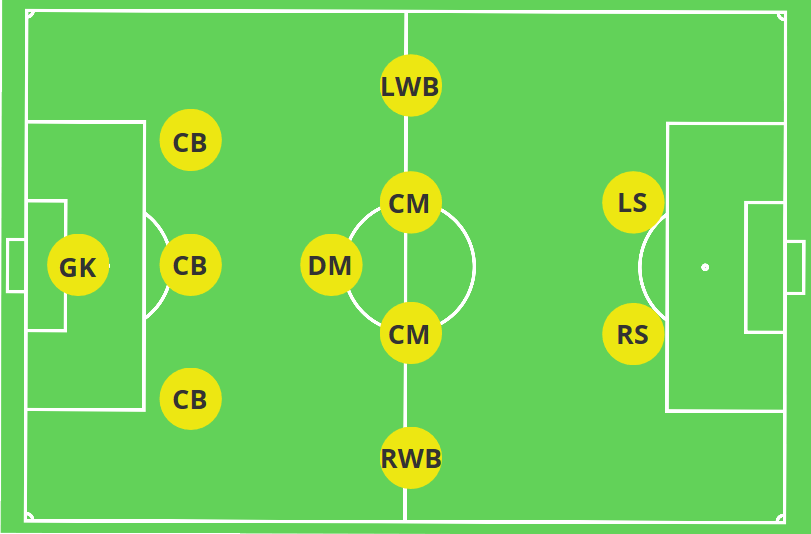Soccer Ball 2023: is a comprehensive article that delves into the evolution of soccer formations, highlighting their historical significance and modern adaptations. It provides insights into how tactical strategies have evolved over the years, shaping the way the game is played today.

Early Days: 2-3-5 Formation

Origins of the 2-3-5 Formation
The 2-3-5 formation, also known as the “pyramid” formation, emerged in the early days of football and represented the foundational structure of the sport. This tactical setup featured two full-backs, three half-backs, and five forwards, prioritizing an aggressive and attacking style of play. The rationale behind this formation was to overwhelm the opposition with sheer numbers in the attacking third of the field. By deploying a majority of players in forward positions, teams aimed to maintain continuous pressure on the opponent’s defense. While highly effective in its time, the 2-3-5 formation eventually evolved to address its vulnerability in defense, leading to the development of more balanced tactical systems.
Soccer Ball 2023: Analysis
The 2-3-5 formation, also known as the “pyramid” formation, was the prevalent tactical setup in the early days of football. With a heavy focus on attack, it allowed for an aggressive, high-scoring style of play. However, its vulnerability in defense became increasingly apparent as the game progressed.
The W-M Formation: A Revolutionary Shift
In the early 20th century, football predominantly followed a 2-3-5 formation, which featured two defenders, three midfielders, and five forwards. However, in the 1920s, Herbert Chapman, the visionary manager of Arsenal, introduced the revolutionary W-M formation.
Historical Insights
- Formation Structure: The W-M formation, as the name suggests, resembled the shape of the letters ‘W’ and ‘M’ when viewed from above. It featured three defenders, two wing-halves, two inside-forwards, and three forwards.
- Strategic Shift: This formation marked a significant departure from the 2-3-5, as it emphasized a more balanced approach between attack and defense. The wing-halves provided defensive cover while also supporting the attack.
- Tactical Flexibility: The W-M formation allowed for more fluidity in player movement. The wing-halves could drop back to reinforce the defense or push forward to support the attack, providing versatility on the field.
- Legacy: The W-M formation laid the groundwork for modern tactical thinking, influencing subsequent formations and shaping the tactical landscape for decades to come.
Soccer Ball 2023: Analysis
The W-M formation, named after the shapes its players formed on the field, addressed the defensive frailties of the 2-3-5. By adding an extra defender and redistributing players, it struck a better balance between attack and defense. This innovation laid the groundwork for modern tactical developments.
The 4-2-4 Formation: Enter the Brazilian Magic

As football continued to evolve, the 4-2-4 formation emerged as a testament to attacking prowess. This formation, popularized by the Brazilian national team in the 1958 World Cup, showcased a dynamic and aggressive style of play.
Historical Insights
- Formation Structure: The 4-2-4 featured four defenders, two defensive midfielders, four forwards, and no designated midfield playmaker. This structure prioritized attacking prowess over midfield control.
- Brazilian Influence: The Brazilian national team, led by legendary players such as Pelé and Garrincha, showcased the brilliance of the 4-2-4. Their dynamic attacking style left an indelible mark on the footballing world.
- Adaptations and Variations: While the 4-2-4 was known for its attacking flair, teams later adapted it to include more midfield control. This evolution paved the way for formations that balanced attack and defense.
- Legacy: While the 4-2-4 gradually evolved into more balanced formations, its influence on attacking play and flair endured, with elements of its style still seen in modern football.
Soccer Ball 2023: Analysis
The success of the 4-2-4 in the 1962 World Cup solidified its place in football history. Brazil’s inventive use of this formation demonstrated that tactical innovation could lead to unprecedented levels of success. The Brazilian Magic, as it came to be known, showcased the potential for a more flexible, attacking style of play.
The Catenaccio: Italian Defensive Mastery
In the 1960s, Italian football introduced the Catenaccio, a tactical system celebrated for its defensive solidity and counter-attacking prowess. Coaches like Helenio Herrera and Nereo Rocco were instrumental in popularizing this formation.
Historical Insights
- Formation Structure: The Catenaccio relied on a sweeper, or ‘libero,’ positioned behind a line of man-marking defenders. This defensive setup prioritized maintaining a compact defensive shape.
- Counter-Attacking Emphasis: The Catenaccio was characterized by a disciplined defensive approach, focusing on absorbing pressure and launching quick counter-attacks. The emphasis was on organized defending.
- Italian Dominance: Italian clubs and the national team, notably Inter Milan, AC Milan, and the Italian national team, achieved remarkable success with the Catenaccio. It became synonymous with Italian footballing prowess.
- Evolution and Criticism: Over time, variations of the Catenaccio emerged, with some critics arguing it stifled creativity. Nevertheless, it remains a significant chapter in the tactical history of football.
Soccer Ball 2023: Analysis
The Catenaccio was a tactical masterpiece, showcasing Italian mastery in defensive football. Its impact on the sport is undeniable, influencing how teams approach defense to this day. The legacy of the Catenaccio stands as a testament to the enduring importance of a solid defensive foundation in football.
Total Football (Totaalvoetbal): A Dutch Revolution
In the 1970s, Dutch football introduced Total Football, a dynamic system that emphasized fluidity, adaptability, and the versatility of outfield players. This innovative approach transformed traditional notions of player positions.
Historical Insights
- Formation Flexibility: Total Football rejected rigid positions, allowing outfield players to interchange roles seamlessly. This fluidity created a constantly shifting tactical landscape on the pitch.
- Adaptability: Any outfield player could take on the role of another, preserving the team’s intended structure. The goalkeeper was the only player with a designated position.
- Dutch Dominance: The Dutch national team and clubs like Ajax, under the guidance of Rinus Michels and Johan Cruyff, were pioneers of Total Football. They achieved immense success, influencing football worldwide.
- Legacy: Total Football left an indelible mark on football philosophy, influencing subsequent generations of coaches and players. Its principles of adaptability and fluidity continue to inspire modern tactical thinking.
Soccer Ball 2023: Analysis
The influence of Total Football is evident in modern football. Versatility is now a prized attribute in players, and tactical systems often allow for fluidity in positioning. This evolution has led to the emergence of the “false nine” and players who can play multiple roles on the field.
Modern Trends by Soccer Ball 2023:

The 4-4-2 Formation: A Balanced Approach
The 4-4-2 formation is a classic choice for teams seeking equilibrium between offensive and defensive capabilities. With four defenders, four midfielders, and two strikers, it strikes a harmonious chord between creating opportunities and safeguarding the goal.
Tactical Insights
- Attack: The two strikers form a formidable frontline, pressuring the opponent’s defense and capitalizing on goal-scoring chances. This dual-striker system increases the likelihood of goals through coordinated attacks.
- Midfield: The midfielders in this formation play a dual role – they contribute to the attack by creating chances and provide support to the defense when needed. This balanced midfield setup ensures a seamless transition between offense and defense.
- Defense: The backline of four defenders acts as a sturdy barrier, thwarting the adversary’s attempts to breach the goal. This defensive line provides a reliable shield for the goalkeeper and acts as the last line of defense.
Notable Team: England’s 1966 World Cup-winning squad, managed by Sir Alf Ramsey, utilized the 4-4-2 formation to great effect. Geoff Hurst and Roger Hunt led the attack, while Bobby Charlton and Martin Peters provided creativity in midfield.
The 4-3-3 Formation: Unleashing Offensive Power
For teams hungry for goals, the 4-3-3 formation is a go-to choice. This setup emphasizes attack, employing three midfielders to feed opportunities to a trio of strikers.
Tactical Insights
- Attack: With three forwards in the frontline, the team exerts immense pressure on the opposing defense, creating numerous goal-scoring opportunities. The attacking trio provides a dynamic and unpredictable threat to the opposition’s defense.
- Midfield: The three midfielders are instrumental in orchestrating attacks, providing crucial passes to the forwards. This midfield trident acts as the engine room, driving the team’s offensive efforts.
- Defense: While the defenders still hold their ground, they must be vigilant, as the focus is on offense. The defensive line needs to maintain its shape and be prepared for quick transitions.
Notable Team: FC Barcelona, under the management of Pep Guardiola, achieved unprecedented success using the 4-3-3 formation. With Lionel Messi, Samuel Eto’o, and Thierry Henry in the attack, they won numerous titles, including the historic 2008-09 season with six major trophies.
The 4-2-3-1 Formation: Mastery of Midfield Control
The 4-2-3-1 formation is a versatile setup that blends midfield dominance with attacking prowess. It features two defensive midfielders, three attacking midfielders, and a lone striker.
Tactical Insights
- Midfield Control: The two defensive midfielders provide a robust shield for the defense, while also aiding in creating chances. They serve as the linchpin in transitioning play from defense to attack.
- Attacking Midfield: The trio of attacking midfielders take charge of creating opportunities and supporting the lone striker. This trio orchestrates the team’s creative efforts and is crucial in unlocking the opponent’s defense.
- Striker: The sole striker is the focal point for scoring goals, benefiting from the service of the attacking midfielders. This lone striker requires clinical finishing skills and the ability to hold up play.
Diagram by Soccer Ball 2023:

Notable Team: The German national team, led by Joachim Löw, used the 4-2-3-1 formation to win the 2014 FIFA World Cup. With Thomas Müller as the attacking midfielder and Miroslav Klose as the lone striker, they displayed a formidable attacking force.
The 3-5-2 Formation: Fortifying the Defense
When defensive solidity is paramount, the 3-5-2 formation steps into the spotlight. It deploys three defenders, five midfielders, and two strikers to maintain a resilient backline.
Tactical Insights
- Defense: The trio of defenders forms an unyielding barrier, ensuring minimal breaches in the defensive line. This back three provides a robust defense against opposition attacks.
- Midfield Dominance: The five midfielders strike a balance between supporting the defense and initiating attacks. This midfield quintet controls the central areas of the pitch, dictating the tempo of the game.
- Attack: The two strikers must be tactically astute, contributing not only to goals but also to the build-up play. These strikers need to link play effectively and be clinical in front of goal.
Diagram by Soccer Ball 2023:

Notable Team: AC Milan, managed by Arrigo Sacchi in the late 1980s, employed the 3-5-2 formation to dominate European football. With Franco Baresi anchoring the defense and Ruud Gullit and Marco van Basten leading the attack, they won consecutive European Cups in 1989 and 1990.
The 5-3-2 Formation: The Ultimate Defensive Shield
For teams seeking maximum defensive stability, the 5-3-2 formation is the go-to choice. It employs five defenders, three midfielders, and two strikers.
Tactical Insights
- Rock-Solid Defense: The quintet of defenders forms an impregnable wall, making it exceedingly difficult for opponents to breach. This defensive setup provides exceptional cover for the goalkeeper.
- Midfield Contribution: The three midfielders play a pivotal role in both defending and creating chances for the forwards. They act as a crucial link between defense and attack.
- Strikers’ Patience: The two strikers must be patient, waiting for their opportunities to strike and capitalize on goal-scoring chances. They need to be clinical and opportunistic in their finishing.
Notable Team: Italy’s national team, managed by Marcello Lippi, employed the 5-3-2 formation to win the 2006 FIFA World Cup.
FAQs
1. How did the W-M formation get its name?
The W-M formation was named after the shapes its players formed on the field: a “W” in attack and an “M” in defense.
Analysis: This naming convention provided a visual representation of how the formation operated, helping fans and analysts understand its structure.
2. Which team is renowned for popularizing Total Football?
The Netherlands’ national team, particularly during the 1974 World Cup, is credited with popularizing Total Football.
Analysis: The success of the Dutch national team in implementing Total Football on the international stage brought widespread attention and admiration for this innovative tactical approach.
3. Why is the 4-4-2 formation called the “double four”?
The 4-4-2 formation is called the “double four” because it consists of two banks of four players in midfield and defense.
Analysis: This terminology succinctly describes the formation’s structure, emphasizing its balance between midfield and defensive players.
4. Who is considered one of the greatest playmakers in football history?
Diego Maradona, known for his exceptional vision and passing ability, is often regarded as one of the greatest playmakers in football history.
Analysis: Maradona’s influence extended beyond his individual brilliance; his playmaking abilities revolutionized the way the number ten role was perceived and utilized.
5. How does the 4-3-3 formation create attacking opportunities?
The 4-3-3 formation provides a strong midfield presence, allowing for quick transitions from defense to attack and enabling the front three to press the opposition effectively.





![[removal.ai]_41709505-b305-44fd-97ff-5c381de50796-soccer-review-hub-1](http://soccerreviewhub.com/wp-content/uploads/2023/09/removal.ai_41709505-b305-44fd-97ff-5c381de50796-soccer-review-hub-1-1-e1694514490671.png)